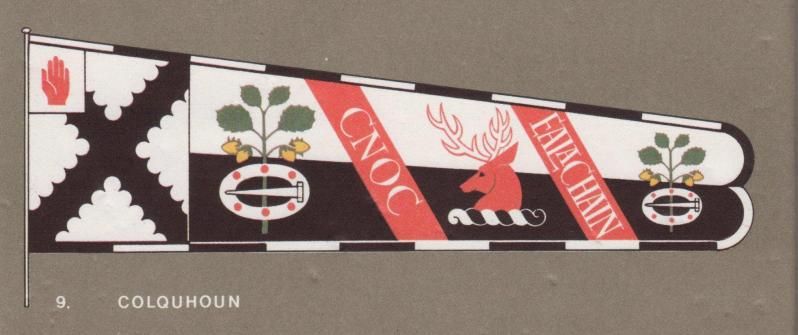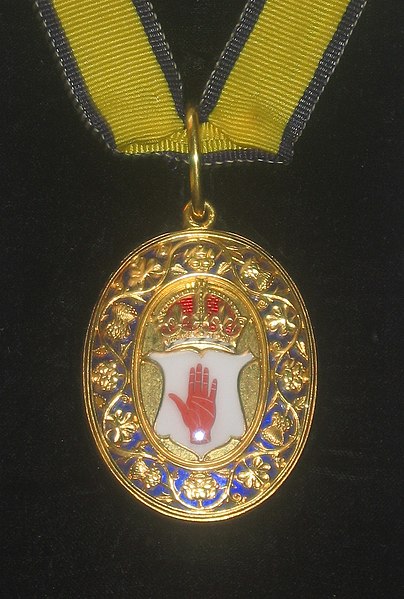|
-
31st July 12, 05:49 AM
#1
Heraldic symbolism on Colquhoun standard
I started to post this in the thread from the 1977 Clan Gathering, but since it's very specific to heraldry, I figured it's better posted here in the heraldry forum.
MacMillan of Rathdown stated:
The hoist (that part nearest the pole) displays either the Arms of the Chief or the Scottish national flag. The rest of the flag (the fly) is made up of the Chief's livery colours, and shows his crest or badge, with or without his other heraldic or plant badges. His motto or slogan is shown on transverse bands.
I'll admit, heraldry confuses me and gives me a headache. But I'll ask anyway, because I don't know very much about it, though I find it fascinating...
On the standard of the late Sir Ivar Colquhoun, reposted below, I notice that the hoist portion generally resembles the Saltire, but is black and white, with the edges of the cross being scalloped. This is the same representation on his Arms, of course, but what is the significance of the scalloping, as well as the colour choice? I've seen vague references to it somehow being tied to the Earls of Lennox, but can't seem to find any further explanation.
Also, I notice the Red Hand in the corner. This confuses me a little. My own ties to Clan Colquhoun came via Ulster (of the Kilpatrick ilk), and it's not unusual for me to see the Red Hand of Ulster associated with my family's history, but I didn't expect to see it on the Colquhoun Chief's standard. It does not escape my attention that it is represented as a left hand, not a right hand. The only information I've seen on this seems to suggest that the left hand is used to denote a baronet, and Sir Ivar was the 8th Baronet of Luss. Is this the extent of the significance (i.e. his being a baronet), or is there more?
The rest of the pennant seems to make sense. I see the clan's wary cry of "Cnoc Ealachain", the red stag that appears on our clan crest, the clan plant badge (hazel), and the black/white which I assume to be the livery colours. But what is the item below the plant badge? Is it a buckle, and if so, what is the significance?

-
-
31st July 12, 05:54 AM
#2
The Ulster Red Hand is a right hand. The one pictured is a left hand which signifies a Baronetage of Nova Scotia if memory serves....
Henry
-
-
31st July 12, 06:42 AM
#3
 Originally Posted by HenryT

The Ulster Red Hand is a right hand. The one pictured is a left hand which signifies a Baronetage of Nova Scotia if memory serves....
Henry
Sorry Henry - not so. This is a Baronet's neck badge:

Nova Scotia Baronets used a representation of the arms of Nova Scotia on their arms.

Regards
Chas
-
-
31st July 12, 06:58 AM
#4
Tobus, the first thing that should be said is that sometimes a cigar is just a cigar. Most of the time there is no hidden meaning behind what is drawn on the shield. There are a fixed number of geometric shapes and a fixed number of different types of edging and a fixed number of colours. The sum total of all these comes to, not very many different possibilities.
Because of the number of limitations, many different Houses will have similar shields, but importantly, not the same shield. Only descendants of the original armiger will have the same shield, but with added differences. In Scotland it is usually a bordure or coloured surround to the whole shield.
The Red Hand shows that the armiger is a Baronet. Descendants (not in the main line) would remove it. The buckle is probably one of the armiger's badges. The Earls of Hereford had between 24 and 36 different badges for different times and different events. Pye Communications Plc were granted 10 different badges for its 10 different departments.
Regards
Chas
Last edited by Chas; 31st July 12 at 06:59 AM.
-
-
31st July 12, 07:20 AM
#5
By way of comparison.
The arms of the Clan Chief of Clan Agnew, Sir Crispin Agnew, 11th Baronet of Lochnaw.
Blazon: Argent a chevron between in chief two fraises Gules and in base a saltire couped Azure. A badge of a Baronet of Nova Scotia.
Regards
Chas
-
-
31st July 12, 07:40 AM
#6
The engrailed ordinary (in this case, the "scalloped" edges of the saltire) in the Stodart System of cadency (a system for making changes to arms based on heraldic seniority/birth order), is the mark of a second son. Having said that, I think in this case Chas is right, as most chiefly arms significantly predate the invention of the Stodart system.
-
-
31st July 12, 07:46 AM
#7
The neck badge of a Baronet of Nova Scotia

Regards
Chas
-
-
31st July 12, 08:08 AM
#8
 Originally Posted by Cygnus

The engrailed ordinary (in this case, the "scalloped" edges of the saltire) in the Stodart System of cadency (a system for making changes to arms based on heraldic seniority/birth order), is the mark of a second son. Having said that, I think in this case Chas is right, as most chiefly arms significantly predate the invention of the Stodart system.
I think the Stodart System is a perfect example of how theory and practice can be diametrically opposed.
In theory, the system should work well. In practice, from day one, there were too many armigers for the system to cope with. Once all the combinations had been used, any new creations would be forced to use a variety of charges rather than ordinaries. So there would be shields within the system and shields outside the system.
The basic error of Stodart and many other systems, is that it tries to be a genealogical record as well as a system of differences. What is required is a system of differences only. It matters not which son is second and which is seventh, provided that the shields are unique. If it mattered, to see it visually, then we would have it written on the shield - B/III/4 (second son of the third son of the fourth son). But no one would put up with that nonsense!
Regards
Chas
-
-
31st July 12, 10:18 AM
#9
Though it's a bit beside the point, here's an exercise of mine to see how far the Stodart System could be taken (in many of the cases I admit that it is much too far).
More on topic - a lot of bucket shops and websites will tell you that the certain colours, patterns, shapes, and charges have particular meanings (red is for courage, blue is for nobility, etc.), and some of the meanings they cite even have some historical precedent as people have tried to assign meaning to such things in the past. In most cases, though , the reason that a coat of arms was designed the way it was is lost and attempts to assign meaning now really are futile.
Some arms are puns or visual representations of the bearer's surname (the arms of most Hunters include a hound and/or a hunting horn, and Lockharts seem to feature a heart in a lock or fetter pretty frequently). In those cases, the meaning is obvious - in other historical arms, if there ever was an intended meaning, I'm not sure how we could even begin to guess.
Last edited by Cygnus; 31st July 12 at 10:48 AM.
-
-
31st July 12, 10:38 AM
#10
Tobus,
As I am sure you know, heraldry is definitely a science in its own right, but like anything else, the more you research and learn, the more you will understand how it works as simply a means of personal identification. I tend to believe that heraldry, especially Scottish Heraldry, can easily confuse the novice heraldic student if they do not fully comprehend the basic fundamentals of heraldic principles and how they should be correctly applied and understood. Of course, the addition of numerous websites and literature on the subject can either prove to be resourceful and dependable tools, or pure rubbish with only snippets of accurate details.
There are many members of the Rabble who are extremely knowledgable when it comes to all things heraldic - especially those who are armigerous themselves. Personally, I have learned much from their intriguing and insightful contributions over the years.
Cheers,
-
 Posting Permissions
Posting Permissions
- You may not post new threads
- You may not post replies
- You may not post attachments
- You may not edit your posts
-
Forum Rules
|
|






















Bookmarks